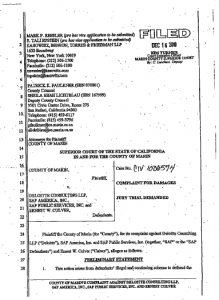A Ten Step Guide to Implementing SAP’s New Security Recommendations
On January 16, SAP issued a revamped version of the whitepaper Secure Configuration of SAP Netweaver Application Server using ABAP, which is rapidly becoming the de-facto standard for securing the technical components of SAP. According to SAP, the guidance provided in the whitepaper is intended to help customers protect ABAP systems against unauthorized access within the corporate network. In fact, many of the recommendations can also be used to protect SAP systems against remote attacks originating outside such a network. These attacks are targeted at the technical components of SAP Netweaver that are responsible for managing user authentication, authorization, encryption, passwords and system interfaces, as well as underlying databases and operating systems. Breaches in these components can enable attackers to take complete control of an SAP environment.
The following is a quick guide to help you comply with SAP’s recommendations.
1. Disable unnecessary network ports and services. In most cases, this means blocking all connections between end user networks and ABAP systems other than those required by the Dispatcher (port 32NN), Gateway (33NN), Message Server (36NN) and HTTPS (443NN). NN is a placeholder for your SAP instance number. Administrative access should only be allowed through secure protocols such as SSH and restricted to dedicated subnets or workstations through properly configured firewall rules.
2. Install the latest version of SAP GUI. This should be 7.10 or 7.20 with activated security rules configured with the ‘Customized’ setting and the ‘Ask’ default action.
3. Implement strong password policies, restrict access to password hashes in tables and activate the latest hashing algorithms. SAP does not specify the exact settings for password policy parameters but you should use frameworks such as the PCI DSS as a proxy. Refer to section 8.5 of the standard. Default passwords should be changed for standard users and the password hashing mechanism should be upgraded to the latest version available for your system. Wherever possible, downward-compatible hashes should be removed from the database.
4. Enable SNC and SSL. SAP client and server communication traffic is not cryptographically authenticated or encrypted. Therefore, data transmitted within SAP networks can be intercepted and modified through Man-In-The-Middle attacks. Secure Network Communication (SNC) should be used for mutual authentication and strong encryption. This can be performed natively if both servers and clients run on Windows. You will need to use a third party product to secure connections between heterogeneous environments such as AIX to Windows.
SNC will secure network communication using the SAP DIAG and RFC protocols. For Web-based communication, you should switch to HTTPS/ SSL and restrict access to the relevant cryptographic keys.
5. Restrict ICF services. Many of the services enabled by default in the Internet Communication Framework (ICF) are open to abuse and could enable unauthorized and malicious access to SAP systems and resources. At a very minimum, you should deactivate the dozen or so services mentioned by SAP in the white paper. This can be performed through transaction SICF.
6. Secure Remote Function Calls (RFC). Wherever possible, remove trust relationships between systems with differing security classifications and hardcoded user credentials in RFC destinations. The belief that RFC connections using SAP_ALL privileges is fine as long as the user type is not set to dialog is a myth. This represents a serious risk to the integrity of information in SAP systems.
7. Secure the SAP Gateway. The Gateway is used to manage RFC communications which support SAP interfaces such as BAPI, ALE and IDoc. Access Control Lists (ACL) should be created to prevent the registration of rogue or malicious RFC servers which can lead to the interruption of SAP services and compromise data during transit. You should also enable Gateway logging and disable remote access.
8. Secure the SAP Message Server. The Message Server is primarily a load balancer for SAP network communications. Similar to the Gateway, it has no default ACL which means it is open to the same type of attacks. You should filter access to the Message Server port using a firewall and create an ACL for all required interfaces.
9. Regularly patch SAP systems. Implement missing SAP Security Notes and patch systems at least once a month. Security Notes can be downloaded from the SAP Service Market Place.
10. Regularly monitor the SAP security configuration. Standard SAP services such as EarlyWatch (EWA) and the Computing Center Management System (CCMS) can be used to monitor some security-relevant configurations. However, they do not provide the same coverage as professional-grade security tools such as those used by Layer Seven Security. You can learn more about SAP security monitoring through vulnerability assessment here. To discover why vulnerability assessments should be an integral component of your SAP security framework, click here.


